

Problems in China Drive Market Volatility
The market volatility that we’re seeing comes down to the outlook for China. There are two main points to keep in mind.
Economic Slowdown: The first is that China is facing extraordinary pressures. It's at the end of a cyclical boom, where it built up too much excess capacity, and too much credit. And it is trying to digest that at the same time it's trying to maintain economic stability. It is a very challenging environment with a downshift in growth in China.
Currency and Interest Rate Squeeze: The second thing is that China is also being squeezed by the increase in interest rates that the Federal Reserve started to initiate in the U.S. China had kept their exchange rate pegged to the U.S. dollar for quite some time. But it is very difficult to control both your exchange rate and your interest rate. So, as the Federal Reserve moved to tighten, that strengthened the dollar, which in turn strengthened China's currency. It created a tightening in the Chinese system that made it very, very hard for them to ease monetary policy.
So, we're seeing a culmination of both China's economic weakness, as well as, its efforts to try to ease its currency policy. This has really made the markets much more volatile in 2016.
What May Be Ahead
What May Be Ahead
Our outlook is that it is going to continue to be a very volatile backdrop for China, as well as the global financial markets. Over the course of 2016, policymakers in China are going to continue to pour fiscal and monetary stimulus as well as some currency easing into the picture, which should eventually stabilize things in China. It should help stabilize the global environment and perhaps even financial markets as well.
It's quite likely we can continue to see some volatility in the financial markets in the short term, so it is very important to remember your long-term investing objectives.


.jpg)

